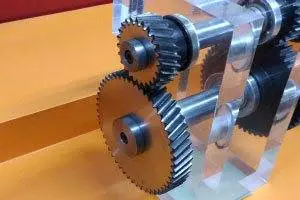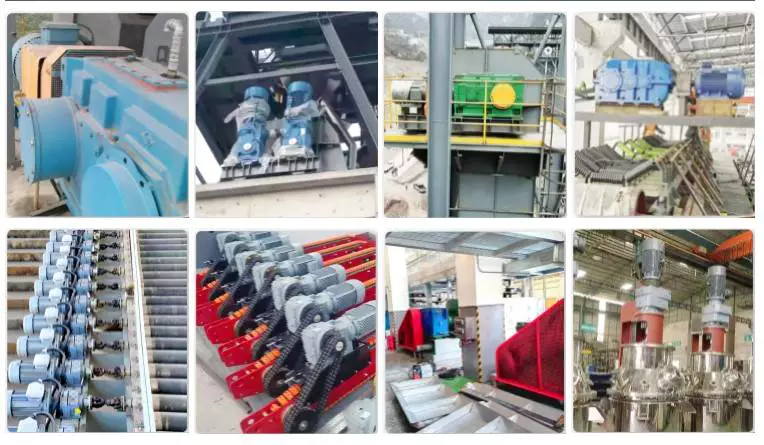Product Description
Product Description
SGR inline shaft with flange helical gear motor
Technical data:
1. Ratio range: 3-20000
2. Input power: 0.12-4 KW
3. Permit torque rang: ≤ 1225 N. M
4. Output speed: 0.09~832 r/min
5. Structure: Foot-mounted, flange-mounted, shaft-mounted
| Input structure | motor,IEC flange |
| Output speed | motor,IEC flange,input shaft |
| solid shaft, hollow shaft with key,with shrink disk |
Characteristic:
1. Closed case, long life, compact structure
2. Helical hard-teeth, low noise, high efficiency
3. Lightweight, favorable adaptability
4. Can be added braker
Production pictures:
———————————————————————————————————————————————
FAQ:
1.Are you a factory or trader ?
We are a professional factory which has 20 years history specialized in gear transmission .
2.MOQ:
Our MOQ is 1pcs. However there is 1 handling cost $150 for the single order which less than $3000.00
3. Warranty
Our warranty is 12months
4. Payment term
100% T/T in advance and LC at sight .
5. Do you accept customization ?
YES.SGR have strong R&D team, we can provide customizable service according to requirements.
6. Packing
Generally we use standard export plywood case to arrange the shipment .
7. Delivery time
In normal ,time of delivery is 30days after receiving the prepayment .
8. What kinds of certification do you use ?
DNV-ISO9001:2008, SGS,CE etc, And new products patent.
9. What kinds of inspection you do before shipment ?
We do temperature test, noise, and oil leak inspection and commissioning before shipment.
10.How do you solve if the production have problem ?
Mostly, we don’t need customer send the goods back to us. Because the cost is very high, if there meets a problem,we firstly ask for the pictures for damaged parts. And base on the pictures, we can have a basic idea for the defect reason. Our guarantee is 12 months, if during the guarantee, we can supply repair .
| Application: | Machinery |
|---|---|
| Function: | Speed Reduction |
| Layout: | Coaxial |
| Hardness: | Hardened Tooth Surface |
| Installation: | Horizontal Type |
| Step: | Stepless |
| Samples: |
US$ 200/Piece
1 Piece(Min.Order) | |
|---|
| Customization: |
Available
| Customized Request |
|---|

What Is a Helical Gearbox?
Generally, the gear is a rotating circular machine part, and its purpose is to transmit speed and torque. It works by meshing with other toothed parts. This type of gear is made up of cut teeth, inserted teeth, and gear teeth.
Helix angle
Typical helical gearbox angle ranges from 15 to 30 degrees. It is commonly used in worm gears and screws. The angle is important in motion conversion and power transfer.
Helical gearboxes are suitable for high load applications. Because the teeth engage more gradually, helical gearboxes require bearings that can manage axial loading. In fact, the forces produced by helical gears are much less than those of spur gears. Moreover, helical gearboxes are often less efficient.
There are two basic gear systems: the spur gear system and the helical gear system. These systems are similar in their basic functions. However, they are distinguished by a number of important differences. The spur gear system produces thrust forces, while the helical gear system transmits energy through two axial configurations. Both systems operate at speeds of around 50m/s.
Spur gears have a common pitch, whereas helical gears have a different pitch. The pitch of helical gears changes as the helix angle changes. This leads to a difference in the diameter of the gear and the hobs. This changes the radial module system pitch and increases the manufacturing costs.
The normal pressure angle is the angle of the load line into the plane normal to the tooth axis. This angle is sometimes called the reference value.
Helical gears are available in both left-hand and right-hand configurations. Helical gears are typically characterized by quiet operation and higher power carrying capacity. They are also appreciated for their NVH characteristics. They are used in the oil, food, and plastic industries. They also have a higher efficiency than zero-helix angle gears.
Efficiency
Using helical gears in a gearbox provides several benefits. They are more efficient, quieter and better able to handle high load cases. However, they are also more expensive than classic gears.
The efficiency of a helical gearbox is calculated by measuring the efficiency of the entire working area. This is measured using a predefined measuring grid. The result is presented by an efficiency contour map. It shows that efficiency is not uniform in the working area.
This is because of the varying angles of the teeth of the gears. It is also important to consider the size of the pitch circle and the angle of the helix. The pitch circle is larger for helical gears than for spur gears. This means more surface contact and more potential for transmission of power between the parallel shafts.
Efficiency calculations for synchronizers are relatively new. Using data from power losses can help estimate the accuracy of these calculations.
The efficiency of a gearbox is mainly dependent on the power range and the torque. The higher the range, the better the efficiency. When the power range is reduced, the efficiency is reduced. The efficiency decreases sharply for high ratio gearboxes.
The efficiency of a gearbox also depends on the type of gearbox. Typically, spur gears are the most efficient, but helical gears are also quite efficient. In the same way that an electrical motor is more efficient than a standard cylinder engine, helical gears are more efficient than spur gears.
Applications
Various industries utilize helical gearboxes for different applications. These gears are primarily used in heavy industrial settings and are also used in the printing and plastic industries.
They are useful in transferring motion between parallel and right-angle shafts. Helical gears are more durable and offer smoother gear operation than other gear types. They are also less noisy and produce less friction.
Typical applications of helical gearboxes include conveyors, coolers, crushers, and other heavy industrial applications. They are also used in the food, chemical, and printing industries.
There are two main types of helical gearboxes: single helical gearboxes and double helical gearboxes. In the single gearbox, the teeth are at a certain angle to the axis. In the double gearbox, the teeth are at opposite angles.
Both gear types have their own advantages. The spur type is more suited for low-speed applications and is also less expensive to manufacture. However, helical gears are more efficient. They are also less noisy and have more teeth meshing capacity.
Helical gears also have a greater pitch circle diameter than spur gears. Because of this, they can tolerate a greater load and are more durable. The helical gearbox also uses thrust bearings to support the thrust force. In order to ensure smooth operation, the helical gears gradually engage.
Helical gears are also used in the automotive industry. They are the most common gear type used in the automotive transmission process.
Spiral teeth vs helical teeth
Depending on the application, there are two types of bevel gears: helical gears and spiral teeth bevel gears. They have a similar geometry, but they perform differently. While helical gears provide smoother operation and higher load carrying capacity, spiral teeth bevel gears are more flexible, reduce the risk of overheating, and have longer service life.
Helical gears are primarily used for helical or crossed shafts. They have teeth that are cut at a precise angle to the gear axis. They provide a smooth action during heavy loads and are used at high speeds. They can also be used for non-parallel shafts. However, they are less efficient than spur gears.
Spur gears are primarily used for parallel shafts. Their straight teeth are parallel to the gear axis. Their teeth come in sudden contact, which causes vibration and a noticeable noise. However, helical gears provide gradual engagement, minimizing vibration and backlash.
The root stress of helical gears is different from spur gears. It is dependent on the helix angle and the web thickness of the gear. The pressure angle of the teeth also affects the curvature radii. These factors affect the transverse contact ratio, which decreases the length of the contact line.
Helical gears are often used to change the angle of rotation by 90 degrees. They can also be used to eliminate shock loading. These gears can be used on parallel or crossed shafts.
PB and PLB Series
PB and PLB series helical gearboxes offer a bevy of benefits that include high power density and a compact modular design. Aside from offering a high output torque, they also offer low maintenance and a long life span. The manufacturers have also gone to great lengths to provide a robust case, a rigid worm and screw thread arrangement and a high reduction ratio. They also provide parallel shaft input options. This means you can use one gearbox to drive a whole train of synchronized gears.
Aside from the fact that it is one of the most durable gearboxes available, it is also one of the most versatile. In fact, the company manufactures a number of gearbox variants, ranging from a single gearbox to a fully modular multiple gearbox design. The high power density means it can operate in tight industrial spaces. PB and PLB series helical Gearboxes are available in a range of sizes, ensuring you find the perfect fit for your application. The PB and PLB Series helical gearboxes are also a cost-effective option for your next application. The company is also able to offer custom solutions to meet your specific needs.
The best part is that you can get your hands on these Gearboxes at a price that is well worth your hard earned dollars. The manufacturers also offer an industry leading warranty. PB and PLB series helical and worm gearboxes are available in a variety of sizes and configurations to suit your application.
Herringbone gears
Using Herringbone gears in helical gearboxes can give the advantages of quiet operation at high speed and minimal axial force. These gears can also be used in heavy machinery applications. However, manufacturing them is more difficult and expensive.
Herringbone gears are similar to double helical gears, except that they do not have a central gap. Originally, they were made by casting to an accurate pattern.
Today, they are characterized by two sets of gear teeth that are stuck together. They have a very high coincidence, which increases the bearing capacity of the gearbox. They also reduce wear and noise.
These gears are usually smaller than double helical gears. This makes them ideal for applications where vibration is high. The large contact area reduces stress. They also have a high carrying capacity. They are used in transmissions, heavy machinery, and differentials.
Herringbone gears are also used in torque gearboxes, especially those that do not have a significant thrust bearing. However, their use is less common because of manufacturing difficulties.
There are several solutions to the problem of making herringbone gears. One solution is to use a central groove to cut the gears. Another is to stack two helical gears together. Another solution is to use older machines that can be rebuilt to make herringbone gears.
Herringbone gears can be processed using milling methods. However, this method cannot be used to process all herringbone gears.

editor by CX 2023-04-24